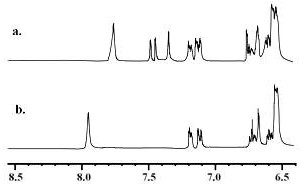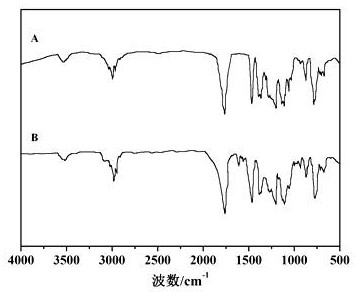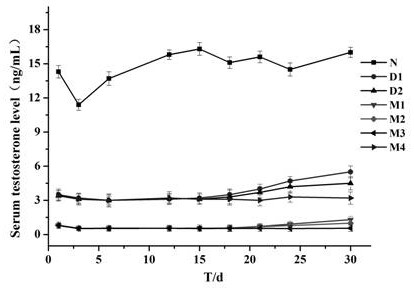A kind of stable leuprolide acetate and its application
A technology of leuprolide acetate and leuprolide, which is applied in the direction of specific peptides, medical preparations with non-active ingredients, medical preparations containing active ingredients, etc. Membrane, low bioavailability and other problems, to achieve better therapeutic effect, improve insulin resistance and high biological activity
- Summary
- Abstract
- Description
- Claims
- Application Information
AI Technical Summary
Problems solved by technology
Method used
Image
Examples
Embodiment 1
[0057] A method for improving the stability of leuprolide acetate:
[0058] Preparation of Leuprolide Conjugates
[0059] Dissolve the protected leuprolide in DMSO (solid-to-liquid ratio: 2.1 g: 1 mL), adjust the pH to 5.6, add 7-methoxy-2-oxobenzopyran-4-acetic acid N-butyl Imide ester, reacted at 36°C for 13h, followed by cation exchange chromatography (19.5mM PBS pH 6.4, sodium chloride gradient: 0.1, 0.3, 0.5M) purification, dialysis, and lyophilization to obtain leuprolide coupling thing. Wherein, the molar ratio of leuprolide acetate and 7-methoxy-2-oxobenzopyran-4-acetic acid N-succinimide ester is 1: 1.2;
[0060] Take the protected couple and add the volume ratio TFA:Tis:H 2 In a solution of O=95.5:2:2.5, stirred at room temperature for 6 h, precipitated with isopropyl ether, filtered, purified by Sephadex Superdex 200 column chromatography, concentrated, and freeze-dried to obtain a leuprolide conjugate.
[0061] A salt
[0062] Get leuprolide conjugate and be d...
Embodiment 2
[0070] Preparation of PLA-co-PEG-Mal copolymer:
[0071] S1: Dehydration of polyethylene glycol, take toluene and add polyethylene glycol, reflux and azeotrope at 106°C for 4.5 hours, evaporate toluene and water under reduced pressure to obtain purified polyethylene glycol;
[0072] S2: Use xylene as the reaction solvent, add L-lactide, heat and stir to dissolve, add the catalyst stannous octoate, then add purified polyethylene glycol drop by drop, control the reaction temperature at 128°C, stir for 18 hours; then reduce Xylene was removed by pressure distillation, chloroform was added to dissolve, methanol was precipitated, filtered, and after 4 cycles of vacuum drying, intermediate M was obtained; wherein the mass ratio of L-lactide to polyethylene glycol was 1:0.12; the catalyst octanoic acid The addition of stannous is 1.7% of monomer quality;
[0073] S3: Dissolve intermediate M in dichloromethane, add acid-binding agent pyridine, then add maleic anhydride, react at 62°C...
Embodiment 3
[0082] The difference between a method for improving the stability of leuprolide acetate and Example 2: using modified PLA-co-PEG-Mal copolymer instead of PLA-co-PEG-Mal copolymer.
[0083] The difference between the preparation of modified PLA-co-PEG-Mal copolymer and the preparation of PLA-co-PEG-Mal copolymer in Example 2: adding 2',3'-dihydro-2',3'- Dihydroxysafrole; the mass ratio of L-lactide to 2',3'-dihydro-2',3'-dihydroxysafrole is 1:0.73. The molecular weight of the copolymer is 35.2 kDa.
PUM
| Property | Measurement | Unit |
|---|---|---|
| molecular weight | aaaaa | aaaaa |
| molecular weight | aaaaa | aaaaa |
| molecular weight | aaaaa | aaaaa |
Abstract
Description
Claims
Application Information
 Login to View More
Login to View More - R&D
- Intellectual Property
- Life Sciences
- Materials
- Tech Scout
- Unparalleled Data Quality
- Higher Quality Content
- 60% Fewer Hallucinations
Browse by: Latest US Patents, China's latest patents, Technical Efficacy Thesaurus, Application Domain, Technology Topic, Popular Technical Reports.
© 2025 PatSnap. All rights reserved.Legal|Privacy policy|Modern Slavery Act Transparency Statement|Sitemap|About US| Contact US: help@patsnap.com



